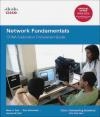Network Fundamentals
Antoon Rufi, Rick McDonald, Mark Dye
Network Fundamentals
Antoon Rufi, Rick McDonald, Mark Dye
- Producent: Cisco Press
- Rok produkcji: 2011
- ISBN: 9781587133480
- Ilość stron: 560
Niedostępna
Opis: Network Fundamentals - Antoon Rufi, Rick McDonald, Mark Dye
Each new purchase of an Exploration Companion guide comes with an exclusive coupon code that can be used to Save 65% on these two additional study resources: 1. CCENT 640-822 Network Simulator: Software Download (www.ciscopress.com/title/1587202174) 2. Network Fundamentals Companion Guide eBook (www.ciscopress.com/title/0132877449) Network Fundamentals, CCNA Exploration Companion Guide is the official supplemental textbook for the Network Fundamentals course in the Cisco(R) Networking Academy(R) CCNA(R) Exploration curriculum version 4. The course, the first of four in the new curriculum, is based on a top-down approach to networking. The Companion Guide, written and edited by Networking Academy instructors, is designed as a portable desk reference to use anytime, anywhere. The book's features reinforce the material in the course to help you focus on important concepts and organize your study time for exams. New and improved features help you study and succeed in this course: *Chapter objectives-Review core concepts by answering the focus questions listed at the beginning of each chapter. *Key terms-Refer to the updated lists of networking vocabulary introduced and highlighted in context in each chapter. *Glossary-Consult the comprehensive glossary with more than 250 terms. *Check Your Understanding questions and answer key-Evaluate your readiness with the updated end-of-chapter questions that match the style of questions you see on the online course quizzes. The answer key explains each answer. *Challenge questions and activities-Strive to ace more challenging review questions and activities designed to prepare you for the complex styles of questions you might see on the CCNA exam. The answer key explains each answer. How To-Look for this icon to study the steps you need to learn to perform certain tasks. Packet Tracer Activities- Explore networking concepts in activities interspersed throughout some chapters using Packet Tracer v4.1 developed by Cisco. The files for these activities are on the accompanying CD-ROM. Also available for the Network Fundamentals Course Network Fundamentals, CCNA Exploration Labs and Study Guide ISBN-10: 1-58713-203-6 ISBN-13: 978-1-58713-203-2 Companion CD-ROM The CD-ROM provides many useful tools and information to support your education: * Packet Tracer Activity exercise files v4.1 * VLSM Subnetting Chart * Structured Cabling Exploration Supplement * Taking Notes: a .txt file of the chapter objectives *A Guide to Using a Networker's Journal booklet * IT Career Information * Tips on Lifelong Learning in Networking This book is part of the Cisco Networking Academy Series from Cisco Press(R). The products in this series support and complement the Cisco Networking Academy online curriculum.Introduction Chapter 1 Living in a Network-Centric World Objectives Key Terms Communicating in a Network-Centric World Networks Supporting the Way We Live Examples of Today's Popular Communication Tools Networks Supporting the Way We Learn Networks Supporting the Way We Work Networks Supporting the Way We Play Communication: An Essential Part of Our Lives What Is Communication? Quality of Communication The Network as a Platform Communicating over Networks Elements of a Network Converged Networks The Architecture of the Internet The Network Architecture Fault-Tolerant Network Architecture Scalable Network Architecture Providing Quality of Service Providing Network Security Trends in Networking Where Is It All Going? Networking Career Opportunities Summary Activities and Labs Check Your Understanding Challenge Questions and Activities To Learn More Chapter 2 Communicating over the Network Objectives Key Terms The Platform for Communications The Elements of Communication Communicating the Messages Components of the Network End Devices and Their Role on the Network Intermediary Devices and Their Role on the Network Network Media LANs, WANs, and Internetworks Local-Area Networks Wide-Area Networks The Internet: A Network of Networks Network Representations Protocols Rules That Govern Communications Network Protocols Protocol Suites and Industry Standards Interaction of Protocols Technology-Independent Protocols Using Layered Models The Benefits of a Layered Model Protocol and Reference Models TCP/IP Model Communication Process Protocol Data Units and Encapsulation Sending and Receiving Process OSI Model Comparing the OSI Model to the TCP/IP Model Network Addressing Addressing in the Network Getting Data to the End Device Getting Data Through the Internetwork Getting Data to the Right Application Summary Activities and Labs Check Your Understanding Challenge Questions and Activities To Learn More Chapter 3 Application Layer Functionality and Protocols Objectives Key Terms Applications: The Interface Between the Networks OSI and TCP/IP Model Application Layer Software User Applications, Services, and Application Layer Protocols Application Layer Protocol Functions Making Provisions for Applications and Services Client/Server Model Servers Application Layer Services and Protocols Peer-to-Peer (P2P) Networking and Applications Application Layer Protocols and Services Examples DNS Services and Protocol WWW Service and HTTP E-Mail Services and SMTP/POP Protocols E-Mail Server Processes: MTA and MDA FTP DHCP File-Sharing Services and SMB Protocol P2P Services and Gnutella Protocol Telnet Services and Protocol Summary Activities and Labs Check Your Understanding Challenge Questions and Activities To Learn More Chapter 4 OSI Transport Layer Objectives Key Terms Roles of the Transport Layer Purpose of the Transport Layer Supporting Reliable Communication TCP and UDP Port Addressing Segmentation and Reassembly: Divide and Conquer TCP: Communicating with Reliability Making Conversations Reliable TCP Server Processes TCP Connection Establishment and Termination TCP Three-Way Handshake TCP Session Termination TCP Acknowledgment with Windowing TCP Retransmission TCP Congestion Control: Minimizing Segment Loss UDP: Communicating with Low Overhead UDP: Low Overhead Versus Reliability UDP Datagram Reassembly UDP Server Processes and Requests UDP Client Processes Summary Labs Check Your Understanding Challenge Questions and Activities To Learn More Chapter 5 OSI Network Layer Objectives Key Terms IPv4 Network Layer: Communication from Host to Host IPv4: Example Network Layer Protocol IPv4 Packet: Packaging the Transport Layer PDU IPv4 Packet Header Networks: Dividing Hosts into Groups Creating Common Groups Why Separate Hosts into Networks? Dividing Networks from Networks Routing: How Data Packets Are Handled Device Parameters: Supporting Communication Outside the Network IP Packets: Carrying Data End to End Gateway: The Way Out of the Network Route: A Path to a Network Destination Network Next Hop: Where the Packet Goes Next Packet Forwarding: Moving the Packet Toward Its Destination Routing Processes: How Routes Are Learned Static Routing Dynamic Routing Routing Protocols Summary Labs Check Your Understanding Challenge Questions and Activities To Learn More Chapter 6 Addressing the Network: IPv4 Objectives Key Terms IPv4 Addresses Anatomy of an IPv4 Address Binary-to-Decimal Conversion Decimal-to-Binary Conversions Addressing Types of Communication: Unicast, Broadcast, Multicast IPv4 Addresses for Different Purposes Types of Addresses in an IPv4 Network Range Subnet Mask: Defining the Network and Host Portions of the Address Public and Private Addresses Special Unicast IPv4 Addresses Legacy IPv4 Addressing Assigning Addresses Planning to Address the Network Static or Dynamic Addressing for End-User Devices Selecting Device Addresses Internet Assigned Numbers Authority (IANA) ISPs Calculating Addresses Is the Host on My Network? Calculating Network, Hosts, and Broadcast Addresses Basic Subnetting Subnetting: Dividing Networks into Right Sizes Subnetting a Subnet Testing the Network Layer Ping 127.0.0.1: Testing the Local Stack Ping Gateway: Testing Connectivity to the Local LAN Ping Remote Host: Testing Connectivity to Remote LAN Traceroute (tracert): Testing the Path ICMPv4: The Protocol Supporting Testing and Messaging Overview of IPv6 Summary Labs Check Your Understanding Challenge Questions and Activities To Learn More Chapter 7 OSI Data Link Layer Objectives Key Terms Data Link Layer: Accessing the Media Supporting and Connecting to Upper-Layer Services Controlling Transfer Across Local Media Creating a Frame Connecting Upper-Layer Services to the Media Standards MAC Techniques: Placing Data on the Media MAC for Shared Media MAC for Nonshared Media Logical Topology Versus Physical Topology MAC: Addressing and Framing Data Data Link Layer Protocols: The Frame Framing: Role of the Header Addressing: Where the Frame Goes Framing: Role of the Trailer Sample Data Link Layer Frames Putting It All Together: Following Data Through an Internetwork Summary Labs Check Your Understanding Challenge Questions and Activities To Learn More Chapter 8 OSI Physical Layer Objectives Key Terms Physical Layer: Communication Signals Purpose of the Physical Layer Physical Layer Operation Physical Layer Standards Physical Layer Fundamental Principles Physical Signaling and Encoding: Representing Bits Signaling Bits for the Media Encoding: Grouping Bits Data-Carrying Capacity Physical Media: Connecting Communication Types of Physical Media Copper Media Media Connectors Summary Labs Check Your Understanding Challenge Questions and Activities To Learn More Chapter 9 Ethernet Objectives Key Terms Overview of Ethernet Ethernet: Standards and Implementation Ethernet: Layer 1 and Layer 2 Logical Link Control: Connecting to the Upper Layers MAC: Getting Data to the Media Physical Implementations of Ethernet Ethernet: Communication Through the LAN Historic Ethernet Legacy Ethernet Current Ethernet Moving to 1 Gbps and Beyond Ethernet Frame Frame: Encapsulating the Packet Ethernet MAC Address Hexadecimal Numbering and Addressing Another Layer of Addressing Ethernet Unicast, Multicast, and Broadcast Ethernet MAC MAC in Ethernet CSMA/CD: The Process Ethernet Timing Interframe Spacing and Backoff Ethernet Physical Layer 10- and 100-Mbps Ethernet 1000-Mbps Ethernet Ethernet: Future Options Hubs and Switches Legacy Ethernet: Using Hubs Ethernet: Using Switches Switches: Selective Forwarding Address Resolution Protocol (ARP) Resolving IPv4 Addresses to MAC Addresses Maintaining a Cache of Mappings ARP Broadcast Issues Summary Labs Check Your Understanding Challenge Questions and Activities To Learn More Chapter 10 Planning and Cabling Networks Objectives Key Terms LANs: Making the Physical Connection Choosing the Appropriate LAN Device Device Selection Factors Device Interconnections LAN and WAN: Getting Connected Making LAN Connections Making WAN Connections Developing an Addressing Scheme How Many Hosts in the Network? How Many Networks? Designing the Address Standard for Your Internetwork Calculating the Subnets Calculating Addresses: Case 1 Calculating Addresses: Case 2 Device Interconnections Device Interfaces Making the Device Management Connection Summary Labs Check Your Understanding Challenge Questions and Activities To Learn More Chapter 11 Configuring and Testing Your Network Objectives Key Terms Configuring Cisco Devices: IOS Basics Cisco IOS Access Methods Configuration Files Introducing Cisco IOS Modes Basic IOS Command Structure Using CLI Help IOS Examination Commands IOS Configuration Modes Applying a Basic Configuration Using Cisco IOS Naming Devices Limiting Device Access: Configuring Passwords and Banners Managing Configuration Files Configuring Interfaces Verifying Connectivity Test the Stack Testing the Interface Testing the Local Network Testing Gateway and Remote Connectivity Tracing and Interpreting Trace Results Monitoring and Documenting Networks Basic Network Baselines Capturing and Interpreting Trace Information Learning About the Nodes on the Network Summary Labs Check Your Understanding Challenge Questions and Activities To Learn More Appendix Check Your Understanding and Challenge Questions Answer Key Glossary
Szczegóły: Network Fundamentals - Antoon Rufi, Rick McDonald, Mark Dye
Tytuł: Network Fundamentals
Autor: Antoon Rufi, Rick McDonald, Mark Dye
Producent: Cisco Press
ISBN: 9781587133480
Rok produkcji: 2011
Ilość stron: 560
Waga: 1.18 kg





























